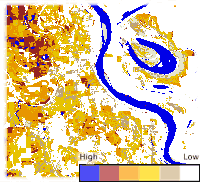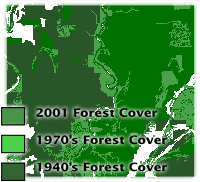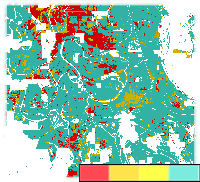DU GIS mapping tool for conservation planning in the Mississippi Alluvial Valley
The Siting Wetlands in the Alluvial Mississippi Plain (SWAMP) Decision Support System and many of its component datasets as accessible on the following page were funded in large part by the USDA Forest Service for the Restoring the Delta Large-scale Watershed Restoration Program.
The information accessible through this system is unsuited for, and shall not be used for, any regulatory purpose of action, nor shall any component thereof be the basis for any determination relating to impact assessment or mitigation. The data contained herein were developed solely for regional conservation planning purposes. Any use of this Information is to be made at the sole risk of the user(s).
Any user who wishes to include results derived from this system in publication or presentation must first acquire consent from Ducks Unlimited and must credit Ducks Unlimited and the USDA Forest Service as the source. For additional information about the system, data, or component projects, please contact us.
The Mississippi Alluvial Valley, the largest floodplain in North America, and one if its most biologically diverse ecoregions, has experienced extensive ecological degradation over the last century. Currently, the MAV is the focus of significant restoration efforts from various sectors, including governmental, non-profit, and private. Ducks Unlimited, the world's leading wetland conservation organization has developed a set of powerful tools packaged within the Siting Wetlands in the Alluvial Mississippi Plain (SWAMP) Decision Support System for conservation planning within the MAV. SWAMP represents the culmination of a suite of ecological and conservation datasets, outlined below, that were developed through the efforts of numerous regional conservation partners.

Hydrologic functionality stands as likely the single most important factor in the ecological integrity of wetland ecosystems, with bottomland hardwood systems not withstanding. The Flood Probability Dataset, jointly funded by DU and the USDA Forest Service with contributions from the LMVJV office, meets the critical need for accurate data of natural hydrology, specifically flood regimes, for prioritizing wetland restoration sites within the MAV. The dataset represents relative flooding frequency for the stream network of the MAV and was created through an analysis of stream gage data archives and Landsat satellite imagery.

In the case of the MAV, sites that have been ditched to hasten drainage (loss of hydrologic indicators) and intensively cropped (loss of vegetative indicators) are commonplace, thereby leaving soils as potentially the only reliable wetland indicator. These facts underlie the need for quality data representing the spatial distribution of soil moisture characteristics. The Soil Moisture Index, a project jointly funded by the USDA Forest Service and DU, was created for use as a surrogate for digital hydric soils data for the MAV using Landsat satellite imagery acquired during the drought conditions of winter 1999. Using winter drought imagery ensured a more accurate evaluation of soil moisture-retention capacity by minimizing the effects of vegetation in agricultural fields and surface water in satellite imagery analysis. SMI values were only determined for bare soil sites; all sites with ground cover during the winter of 1999 were not assigned a class value.

The clearing of the MAV's forests generally occurred from the highest and driest sites to lowest and wettest. By identifying the most recently cleared areas and establishing a chronology of deforestation, analysts can identify those sites that were or are the wettest and only recently became viable to convert to agriculture because of flood control and the rise of new crop alternatives, namely soybeans. However, the fall of certain agricultural commodity prices and the rise of reforestation incentive programs for landowners over the past two decades have spurred a reversal of the trend in such a way that it is now precisely these areas of recent forest change that are prime candidates for reforestation and wetland restoration. Because the extents of bottomland hardwood forests are fairly conspicuous in aerial surveys, they represent the single most assessable indicator of wetland vegetation for MAV-wide analyses. In order to achieve the goal of quantifying and modeling forest loss in the MAV, DU and the USDA Forest Service jointly funded two projects, with the collaboration of numerous partners in the Lower Mississippi Valley Joint Venture partnership, that quantifies the forest extents and rates and locales of forest change for the late 1940s using historic aerial photos on through the 1970s, 1980s, 1990s and 2001 using Landsat satellite imagery.

In order to help direct conservation projects geared to wetland and floodplain restoration to the sites of highest ecological benefit, Ducks Unlimited and the USDA Forest Service jointly funded the development of a Wetland Restoration Suitability Model. The WRS Model was designed in line with DU's conservation priorities and was theoretically constructed around the three cornerstones of wetland delineation and taxonomy widely accepted by wetland science professionals: hydrology, soils, and vegetation. As users can see for themselves, DU aligned a number of its major data development projects described above to approximate these wetland characteristics. The datasets specifically incorporated into the WRS Model include, by category: hydrogeomorphology (Flood Probability, Areas of Internal Drainage, Stream Buffers), Soils (Soil Moisture Index) and Vegetation (Forest Change). The WRS Model provides users with four classes of restoration suitability, or more exactly a measure of the relative likelihood of a site being capable of sustaining a functioning wetland. Results are depicted as four suitability classes: High, Medium-High, Medium-Low, and Low. The prioritization and ranking of input variables was determined by Ducks Unlimited conservation planners and designed to give users a more comprehensive view of the ecological parameters that affect the potential capacity of every site in the MAV to sustain wetland ecological functionality. In addition to the data layers described above, the WRS model also incorporates an Area of Internal Drainage dataset derived from digital elevation data and a stream buffer dataset derived from the National Hydrography Dataset. All sites within the MAV without a WRS value were excluded because they are either already forested, already managed for conservation purposes, or contain permanent modifications such as roads or urban areas that make restoration there cost-prohibitive. Users should use caution when utilizing WRS Model results and not discount local area expertise. The WRS Model output should not entirely take the place of normal in-situ analyses and observations.
Ducks Unlimited uses cookies to enhance your browsing experience, optimize site functionality, analyze traffic, and deliver personalized advertising through third parties. By continuing to use this site, you agree to our use of cookies. View Privacy Policy